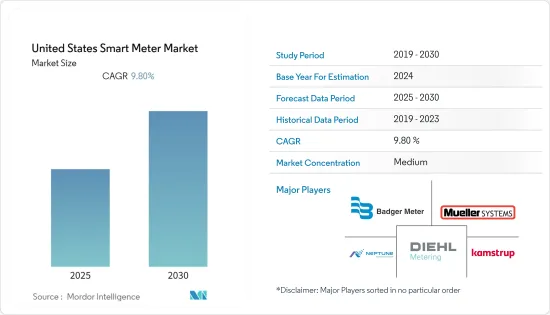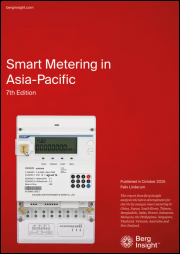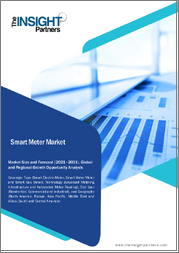
|
시장보고서
상품코드
1632096
미국의 스마트 미터 : 시장 점유율 분석, 산업 동향 및 통계, 성장 예측(2025-2030년)United States Smart Meter - Market Share Analysis, Industry Trends & Statistics, Growth Forecasts (2025 - 2030) |
||||||
■ 보고서에 따라 최신 정보로 업데이트하여 보내드립니다. 배송일정은 문의해 주시기 바랍니다.
미국의 스마트 미터 시장은 예측 기간 동안 CAGR 9.8%를 기록할 것으로 예상됩니다.

주요 하이라이트
- 전력회사가 에너지 발전, 송전, 배전을 관리하기 위해 보다 효율적이고 신뢰할 수 있으며 안전한 방법을 모색하는 가운데, 스마트 그리드는 낭비를 줄이면서 특정 시장의 에너지 공급을 수요에 맞출 수 있는 효과적인 접근법으로 부상하고 있습니다. 스마트 미터는 스마트 그리드에서 사용되는 가장 중요한 장치 중 하나이며, 전력회사와 고객과의 양방향 통신 기능을 갖추고 있습니다. 최근 미국에서는 스마트 그리드 프로젝트에 대한 투자가 증가하고 있으며, 정부의 다양한 정책, 특히 의무화 및 재정적 인센티브가 스마트 계량기 시장 도입의 주요 촉진요인으로 작용하고 있습니다.
- 예를 들어, 미국 농무부는 2021년 9월, 48개 주와 푸에르토리코의 농촌 지역, 농업 생산자 및 기업의 에너지 비용 절감을 위해 재생에너지 인프라를 구축하거나 개선하기 위해 4억 6,400만 달러를 투자할 것이라고 발표했습니다. 농무부는 Electric Loan Program을 통해 스마트 그리드 기술 투자 1억 2천만 달러를 포함한 3억 3,500만 달러를 융자했습니다.
- 또한, 스마트하고 친환경적인 서비스에 대한 소비자 수요는 지속적으로 증가하고 있으며, 소비자들은 현재 사용량을 최적화하고 요금을 절감할 수 있는 개인화된 서비스를 원하고 있습니다. 스마트 미터 데이터를 통해 전력회사는 고객의 에너지 비용 절감을 지원할 수 있으며, 이는 시장 성장을 촉진하는 요인으로 작용하고 있습니다.
- COVID-19가 시작된 초기에 많은 스마트 미터 제조업체들이 직면한 주요 영향은 생산 중단으로 인한 공급 문제였습니다. 또한, 봉쇄 조치로 인해 스마트 미터의 주거용, 상업용, 산업용 수요도 감소했습니다. 그러나 COVID-19로 인한 봉쇄가 완화되면서 스마트 미터의 생산과 공급이 정상 수준으로 돌아오고 있으며, 많은 제조업체들이 판매를 회복하기 시작했습니다.
- 그러나 스마트 미터 인프라 설치에 소요되는 초기 투자비용은 기존 계량기에 비해 훨씬 높은 편이며, 투자 대비 높은 수익률을 달성하는 데에도 많은 시간이 걸립니다. 막대한 자본이 필요한 것은 에너지 소비자와 전력회사 모두에게 큰 도전이며, 시장 억제요인으로 작용하고 있습니다.
미국의 스마트 미터 시장 동향
스마트 가스 계량기 부문이 크게 성장
- 스마트 가스 계량기는 초음파 또는 전자기 기술을 이용하여 가스 유량을 측정하고 무선 통신을 이용하여 근거리 통신망 또는 광역 통신망에 연결합니다.
- 또한 누출 및 충격 감지 시스템을 갖추고 있어 지진 활동이나 가스 누출이 발생하면 즉시 가스 흐름을 차단하거나 원격 조작을 통해 비상 상황을 감지하여 안전성을 크게 향상시킬 수 있습니다. 스마트 가스 계량기는 저전압 배터리 전원에 의존하여 작동 수명을 연장하고 발화 위험을 방지합니다.
- 스마트 가스 계량기를 통해 가스 회사는 에너지 생산, 배급, 배송 등의 업무를 효율적으로 관리하고 비용을 절감하며 자원 배분을 최적화할 수 있습니다. 고객의 소비량을 원격으로 모니터링하고 가스를 켜고 끌 수 있어 비용이 많이 드는 현장 방문을 피할 수 있습니다.
- 2021년 8월, 미국 전력회사 Louisville Gas and Electric Company(LG&E)와 Kentucky Utilities Company(KU)는 스마트 미터와 스마트 그리드 인프라 및 기술 제공과 관련하여 랜디스 기어와 5년간의 계약을 체결하였습니다. 이 계약에는 93만 개의 스마트 전력계량기, 30만 개의 가스 모듈, 연결용 IoT 네트워크 공급이 포함됩니다.
- 미국 정부의 스마트 미터 설치에 대한 우호적인 정책이 시장 성장을 촉진하는 주요 요인으로 작용하고 있습니다. 또한, 고속 네트워크 기술 및 스마트폰의 보급 확대와 함께 인터넷 보급률이 상승하고 있는 것도 시장 성장에 힘을 실어주고 있습니다. 스마트 가스 계량기와 스마트폰을 동기화하면 스마트폰 앱을 통해 가스 계량기의 원격 모니터링을 쉽게 할 수 있기 때문입니다.
주택 부문이 큰 시장 점유율을 차지
- 미국에서 스마트 미터에 대한 수요가 가장 많은 것은 주택용 스마트 미터로, 더 많은 소비자들이 가정의 전력 사용량을 보다 정확하게 모니터링하기 위해 이 미터를 사용하고 있기 때문입니다. 주거용 스마트 미터의 대부분은 전력회사가 조달 및 설치합니다.
- 주택 부문에서는 주로 에어컨, TV, 냉장고, 조명, 천장 선풍기, 세탁기, 컴퓨터, HVAC(난방, 환기, 공조) 기기 등 가전제품의 사용 증가로 인한 전력 소비 증가가 스마트 미터의 수요를 견인하고 있습니다. 전력회사들은 이러한 기기 가동에 따른 역동적인 전력 수요에 대응할 수 있는 방법을 모색하고 있으며, 이를 위해 스마트 미터에 투자하여 그리드의 복원력과 운영을 강화하고 있습니다.
- 스마트 미터는 또한 분산형 에너지 자원(DER), 에너지 저장 기술, EV 충전 설비를 주택 부문에 통합하는 데 도움이 됩니다.
- 또한, 정확한 검침을 강화하고 소비자와 전력 회사 모두에게 에너지 소비에 대한 투명성을 높이기 위해 가정 내 스마트 미터 채택을 촉진하려는 정부의 노력이 증가하고 있는 것도 시장 성장을 촉진하고 있습니다.
- 미국 에너지부에 따르면, 미국 전역에 이미 1억 개 이상의 첨단 스마트 전기 계량기가 설치되어 있으며, 주택에 설치된 스마트 계량기가 전체의 88%를 차지하고 있습니다. 최신 기술을 활용해 전력망의 효율성을 높이기 위한 노력이 계속되는 가운데, 소비자들은 스마트 미터 설치를 통해 전력 소비를 효율적으로 관리하고 장기적으로 상당한 비용 절감을 실현할 수 있는 기회가 늘어날 것으로 기대됩니다.
미국의 스마트 미터 산업 개요
미국의 스마트 미터 시장은 적당한 경쟁이 있으며, 유력한 기업들이 존재합니다. 이들 기업은 시장 점유율을 높이고 수익성을 높이기 위해 전략적 협력 행동을 활용하고 있습니다.
- 2021년 9월 - Kamstrup은 첨단 계량 시장에서의 제공을 강화하기 위해 새로운 스마트 전력계량기 OMNIA를 발표했습니다. 이 신제품은 셀룰러 IoT를 기반으로 합니다. 셀룰러 IoT는 에너지 회사와 기술 공급업체가 빠르고 안전한 데이터 원격 측정을 위한 탄력적인 네트워크 개발을 모색함에 따라 유틸리티 업계에서 널리 채택되고 있는 통신 표준입니다.
- 2022년 5월 - 넵튠 테크놀러지 그룹(Neptune Technology Group)은 미국에 본사를 둔 기업용 과금 및 수익화 솔루션 제공업체인 빌링플랫폼(BillingPlatform)을 채택하여 넵튠의 스마트 워터 솔루션(스마트 미터와 같은 계측 도구, 네트워크, 소프트웨어 및 물 관련 핵심 업무용으로 설계된 서비스 등)에 사용되는 구독 기반 과금 기능을 도입했습니다. 스마트 미터와 같은 계측 도구, 네트워크, 소프트웨어, 물이라는 중요한 업무를 위해 설계된 서비스 등)에 사용되는 구독 기반 과금 기능을 도입했습니다.
기타 특전:
- 엑셀 형식의 시장 예측(ME) 시트
- 3개월간의 애널리스트 지원
목차
제1장 소개
- 조사 가정과 시장 정의
- 조사 범위
제2장 조사 방법
제3장 주요 요약
제4장 시장 인사이트
- 시장 개요
- 업계의 매력 - Porter's Five Forces 분석
- 공급 기업의 교섭력
- 소비자의 협상력
- 신규 참여업체의 위협
- 경쟁 기업 간의 경쟁 관계
- 대체품의 위협
- 업계 밸류체인 분석
- COVID-19의 발생이 산업에 미치는 영향
제5장 미국의 스마트 미터 시장 : 산업 정책과 정책 규제
제6장 미국의 스마트 미터와 스마트 그리드에 대한 대처
제7장 시장 역학
- 시장 성장 촉진요인
- 스마트 미터 설치를 의무화하는 소비자 인식 확산과 정부 규제
- 스마트 그리드 프로젝트에 대한 투자 증가
- 스마트 시티 개발에 대한 투자 증가
- 시장 과제
- 스마트 미터 설치에 따른 비용 증, 보안에 대한 우려, 통합 어려움
- 고객 정보 시스템, 배전 관리 시스템, 과금 시스템등과의 AMI 통합
제8장 시장 세분화
- 유형별
- 스마트 가스 미터
- 스마트 수도 미터
- 스마트 전력 미터
- 최종사용자별
- 상업
- 산업
- 주택
제9장 스마트 미터 소프트웨어 시스템 연구
제10장 경쟁 구도
- 기업 개요
- Badger Meter Inc.
- Mueller Systems LLC
- Diehl Metering US
- Kamstrup
- Neptune Technology Group Inc.
- General Electric Co.
- Itron Inc.
- Sensus USA Inc.(Xylem Inc.)
- Elster American Meter(Honeywell International Inc.)
제11장 벤더 시장 점유율 분석
제12장 투자 분석
제13장 시장 향후 전망
ksm 25.02.06The United States Smart Meter Market is expected to register a CAGR of 9.8% during the forecast period.

Key Highlights
- As utilities seek more efficient, reliable, and secure ways to manage energy generation, transmission, and distribution, the smart grid has emerged as an effective approach to aligning the supply of energy in a given market with demand while reducing waste. The smart meter is one of the most important devices used in the smart grid and has two-way communication capability between electric utilities and customers. In recent years, increasing investments in smart grid projects along with different government policies, particularly mandates and fiscal incentives, are among the key drivers of market adoption of smart meters in the United States.
- For instance, in September 2021, the U.S. Department of Agriculture announced that it would invest USD 464 million to build or improve renewable energy infrastructure and help rural communities, agricultural producers, and businesses lower energy costs in 48 states and Puerto Rico. The USDA financed USD 335 million of these investments through the Electric Loan Program, including USD 102 million for investments in smart grid technology.
- Further, consumer demand for smart and green services continues to grow and they are now seeking personalized services that enable them to optimize usage and reduce bills. Through smart meter data, utilities are able to help customers reduce energy costs, which is another factor driving the growth of the market.
- At the start of the Covid-19, the primary impact faced by many smart meter manufacturers was supply problems, owing to halted production. Moreover, owing to lockdown measures, demand for residential, commercial, and industrial use of smart meters also decreased. However, with the ease of the pandemic-related lockdowns, manufacturing and supply of smart meters are returning to normal levels, with many manufacturers starting to witness a recovery in sales.
- However, the initial investment involved in setting up smart meter infrastructure is usually much higher as compared to traditional meters, and it also takes a longer time to achieve high returns on investments. The requirement for huge capital poses a significant challenge to both energy consumers and utility providers, which acts as a market restraint.
US Smart Meter Market Trends
Smart Gas Meter Segment to Grow Significantly
- A smart gas meter utilizes ultrasonic or electromagnetic technologies to measure gas flow, while using wireless communication to connect to local or wide area networks, which allows infrastructure maintenance, remote location monitoring, and automatic billing.
- The device also has leakage and shock detection systems that can significantly increase safety by detecting emergency situations and enabling the immediate and remote cutting of the gas flow in case of seismic activity or gas leakage. A smart gas meter relies on low-voltage battery power to extend operational life and avoid ignition hazards.
- Smart gas metering allows gas companies to efficiently manage their operations, including energy production, distribution, and deliveries, while reducing costs and optimizing resource allocation. They can remotely monitor customers' consumption and switch gas on and off to avoid costly onsite visits.
- In August 2021, US utility companies Louisville Gas and Electric Company (LG&E) and Kentucky Utilities Company (KU) signed a five-year contract with Landis+Gyr for the provision of smart meters and smart grid infrastructure and technologies. The agreement includes the supply of 930,000 smart electricity meters, 300,000 gas modules and an IoT network for connectivity.
- Favorable government initiatives towards the installation of smart meters in the US are the primary factors driving the market growth. Further, rising internet penetration along with increased adoption of high-speed network technologies and smartphones are also propelling the market, as the synching of smart gas meters with smartphones can easily be used to perform remote monitoring of the gas meters with smartphone apps.
Residential Sector to Hold a Major Market Share
- The most demand for smart meters in the United States is for residential meters, as more consumers are using these meters to monitor electricity usage at their homes more accurately. The bulk of residential smart meters is procured and installed by utilities.
- In the residential sector, the demand for smart meters is primarily driven by the rising power consumption due to increased use of home appliances like air conditioners, televisions, refrigerators, lighting, ceiling fans, cloth washers, personal computers, and HVAC (Heating, ventilation, and air conditioning) equipment in residential buildings. Utilities are looking for ways to address the dynamic demand for power from the operations of this equipment and are thus investing in smart meters to enhance grid resiliency and operations.
- Smart meters also help in integrating distributed energy resources (DERs), energy storage technologies, and EV charging facilities in the residential sector.
- Further, the increasing government initiatives to boost the adoption of smart meters in households to reinforce accurate meter readings and provide better transparency in energy consumption for both consumers and utility companies are also propelling the market growth.
- As per the United States Department of Energy, over 100 million advanced smart electric meters have already been installed throughout the country, with residential installations representing 88% of the total. With continued efforts to use modern technology to improve the effectiveness of the electric grid, consumers are expected to have more opportunities to manage electricity consumption efficiently and reap significant savings in the long run through the installation of smart meters.
US Smart Meter Industry Overview
The United States smart meter market is moderately competitive and consists of some influential players. These businesses are leveraging strategic collaborative actions to improve their market percentage and enhance their profitability.
- September 2021 - Kamstrup introduced a new smart electricity meter, OMNIA, to enhance its offering within the advanced metering market. The new product is based on cellular IoT, a communications standard that continues to see widespread adoption within the utility industry, as energy companies and technology vendors seek to develop a resilient network for fast and secure data telemetry.
- May 2022 - Neptune Technology Group selected US-based enterprise billing and monetization solution provider, BillingPlatform, for its subscription-based billing capabilities to be used with Neptune's Smart Water solutions, which include measurement tools like smart meters, networks, software, and services designed for the critical work of water.
Additional Benefits:
- The market estimate (ME) sheet in Excel format
- 3 months of analyst support
TABLE OF CONTENTS
1 INTRODUCTION
- 1.1 Study Assumptions and Market Definition
- 1.2 Scope of the Study
2 RESEARCH METHODOLOGY
3 EXECUTIVE SUMMARY
4 MARKET INSIGHTS
- 4.1 Market Overview
- 4.2 Industry Attractiveness-Porter's Five Force Analysis
- 4.2.1 Bargaining Power of Suppliers
- 4.2.2 Bargaining Power of Consumers
- 4.2.3 Threat of New Entrants
- 4.2.4 Intensity of Competitive Rivalry
- 4.2.5 Threat of Substitutes
- 4.3 Industry Value Chain Analysis
- 4.4 Impact of COVID-19 Outbreak on the Industry
5 UNITED STATES SMART METERS MARKET - INDUSTRY POLICIES AND REGULATIONS
6 UNITED STATES SMART METERS AND SMART GRID INITIATIVES
7 MARKET DYNAMICS
- 7.1 Market Drivers
- 7.1.1 Higher Consumer Awareness and Government Regulations Mandating the Installation of Smart Meters
- 7.1.2 Increased Investments in Smart Grid Projects
- 7.1.3 Investments in Smart City Developments
- 7.2 Market Challenges
- 7.2.1 Higher Costs, Security Concerns and Integration Difficulties with the Installation of Smart Meters
- 7.3 AMI integration with customer information system, distribution management system, billing systems, etc.
8 MARKET SEGMENTATION
- 8.1 By Type
- 8.1.1 Smart Gas Meters
- 8.1.2 Smart Water Meters
- 8.1.3 Smart Electricity Meters
- 8.2 By End-User
- 8.2.1 Commercial
- 8.2.2 Industrial
- 8.2.3 Residential
9 STUDY ON SMART METERS SOFTWARE SYSTEM
10 COMPETITIVE LANDSCAPE
- 10.1 Company Profiles
- 10.1.1 Badger Meter Inc.
- 10.1.2 Mueller Systems LLC
- 10.1.3 Diehl Metering US
- 10.1.4 Kamstrup
- 10.1.5 Neptune Technology Group Inc.
- 10.1.6 General Electric Co.
- 10.1.7 Itron Inc.
- 10.1.8 Sensus USA Inc. (Xylem Inc.)
- 10.1.9 Elster American Meter (Honeywell International Inc.)
11 VENDOR MARKET SHARE ANALYSIS
12 INVESTMENT ANALYSIS
13 FUTURE OUTLOOK OF THE MARKET
샘플 요청 목록



















